Insignum AgTech and Purdue researchers collaborate for early monitoring of tar spot disease in corn
Innovation helps corn ‘speak’ by changing color to reveal latent plant infections

Insignum AgTech is collaborating with Purdue University researchers to identify early stages of tar spot disease outbreaks in corn plants by using already present DNA to turn the color of the leaves. (Purdue University photo/C.D. Cruz)
WEST LAFAYETTE, Ind. —
Insignum AgTech has begun a collaboration with researchers in Purdue University’s College of Agriculture and College of Engineering to create tools for farmers to identify early stages of tar spot disease outbreaks in their corn plants.
The collaboration is supported by grants from the Indiana Corn Marketing Council and an Innovation Voucher from the state of Indiana.
Insignum CEO and Purdue alumnus Kyle Mohler said the work brings together expertise in three areas:
- Insignum uses DNA already present in corn plants to develop a new gene that reveals infections at an early stage. The gene uses the plant’s innate response to a fungal spore to cause leaves to form purple spots at the site of infection about a week before disease symptoms can be identified.
- C.D. Cruz, associate professor of botany and plant pathology, is one of the foremost experts in the U.S. in phenotyping tar spot in both greenhouse and field conditions. His work focuses on understanding the epidemiology of the disease. He and his team members Alex Acosta, Mariela Fernandez and Andrés Cruz of the Cruz Lab are inoculating Insignum corn with tar spot to test how the plants reveal the disease prior to the onset of symptoms.
- Jian Jin, associate professor of agricultural and biological engineering, has developed LeafSpec, a patented, hand-held, hyperspectral plant leaf scanner that studies physical characteristics of plants, including early disease symptoms, nutrient deficiency and response to chemical treatments. He and his team will capture images of corn plants in the greenhouse to determine if the color changes can be seen faster and more clearly with the device.
Jin’s team also will develop algorithms that pick up the color changes from drone imagery in Insignum’s 2024 field trials. The work may produce intellectual property to enhance scouting efforts when Insignum commercializes its plant genes.
Tar spot and its damaging effects
Tar spot disease lessens a corn plant’s ability to absorb sunlight, thereby weakening the plant and reducing yield. The disease is caused by the Phyllachora maydis fungus. It creates raised, bumpy black spots called stromata on corn husks, leaves and stalks. Each individual stroma can produce thousands of fungal spores that can quickly infect other plants and fields.
Mohler said tar spot was first detected in the U.S. in 2015.
“By 2023 it was the most damaging pathogen to corn in the country,” he said. “Tar spot’s rate of spread, the amount of damage it causes and the fact many U.S. corn varieties aren’t resistant makes it the most concerning corn disease to American farmers.”
Mohler hypothesizes that Insignum’s technology will turn corn leaves purple to identify the presence of tar spot in a corn plant.
“Farmers can then treat their crops to prevent damage from this devastating disease,” he said. “Treating at the right time is critical to treat the disease. It is challenging to get correct.”
The collaboration is expected to last through the end of 2024.
What they’re saying
C.D. Cruz, Purdue University: “Tar spot has caused significant yield reductions, with losses of up to 50% in severe epidemics. The disease is particularly damaging when it infects early, as seen in 2018 and 2021, when it heavily affected plant development before the dent stage, resulting in substantial yield loss. Traditional control methods, such as fungicide applications, are expensive and require precise timing to be effective. Achieving this precision can be challenging due to varying conditions conducive to tar spot, the need to consider other diseases and fluctuating corn prices. This collaboration is promising, as it aims to develop more effective and timely phenotyping strategies, potentially helping farmers to be better informed about the temporal and spatial development of diseases.”
Jian Jin, Purdue University and LeafSpec: “Having a sensor system for earlier detection of tar spot is critically important for farmers to make timely decisions on field applications. Published literature has already shown that LeafSpec is a leading technology in the detection of such disease symptoms, with its superior spatial-spectral resolutions, unprecedented imaging quality and AI for plant stress recognition. The collaboration between Insignum and LeafSpec is like combining a great magnifier and the best camera for the clearest image of tar spot. We’re all holding our breaths to the result of this summer’s assay.”
Ben Forsythe, director of sustainability and value creation, Indiana Corn Marketing Council: “There is a long list of pressures challenging Indiana farmers and the tools they have to protect their crops. We are always looking for the next wave of technologies that can help those farmers meet upcoming challenges while also opening up opportunities to increase on-farm profitability and improve soil and water quality outcomes. Research and technologies like Insignum could be foundational to Indiana corn production in the years to come, and the Indiana Corn Marketing Council is excited to partner with Kyle and the team to move this forward.”
About Insignum AgTech
Insignum AgTech creates biotechnology that enables plants to use their pigments to warn growers about plant stresses, such as disease, insect pests or low fertility. For more information, visit https://www.insignumagtech.com.
About Purdue Innovates
Purdue Innovates is a unified network at Purdue Research Foundation to assist Purdue faculty, staff, students and alumni in either IP commercialization or startup creation. As a conduit to technology commercialization, intellectual property protection and licensing, startup creation, and venture capital, Purdue Innovates serves as the front door to translate new ideas into world-changing impact.
For more information on licensing a Purdue innovation, contact the Office of Technology Commercialization at otcip@prf.org. For more information about involvement and investment opportunities in startups based on a Purdue innovation, contact Purdue Innovates at purdueinnovates@prf.org.
About Purdue University
Purdue University is a public research institution demonstrating excellence at scale. Ranked among top 10 public universities and with two colleges in the top four in the United States, Purdue discovers and disseminates knowledge with a quality and at a scale second to none. More than 105,000 students study at Purdue across modalities and locations, including nearly 50,000 in person on the West Lafayette campus. Committed to affordability and accessibility, Purdue’s main campus has frozen tuition 13 years in a row. See how Purdue never stops in the persistent pursuit of the next giant leap — including its first comprehensive urban campus in Indianapolis, the Mitchell E. Daniels, Jr. School of Business, Purdue Computes and the One Health initiative — at https://www.purdue.edu/president/strategic-initiatives.
Writer/Media contact: Steve Martin, sgmartin@prf.org
Sources: Kyle Mohler, kyle@insignumagtech.com
C.D. Cruz, cruz113@purdue.edu
Jian Jin, jinjian@purdue.edu



